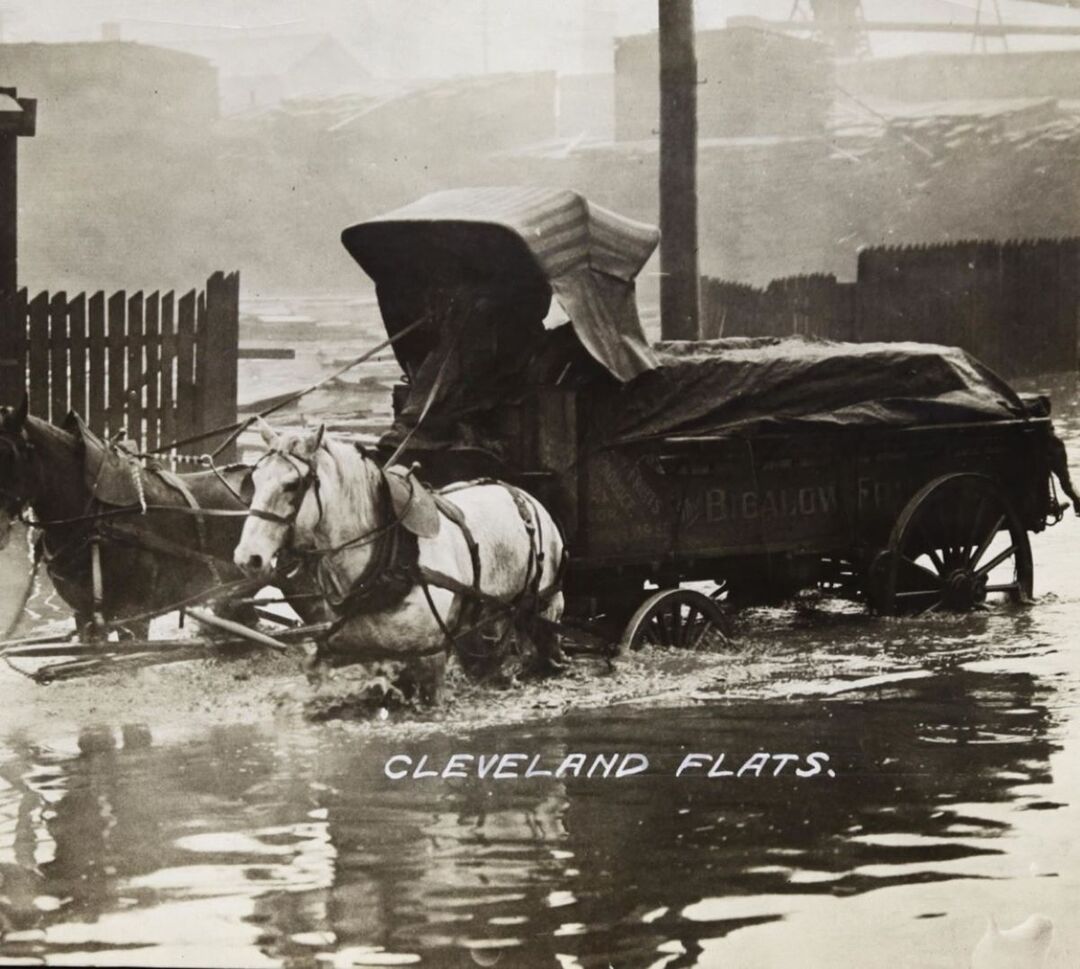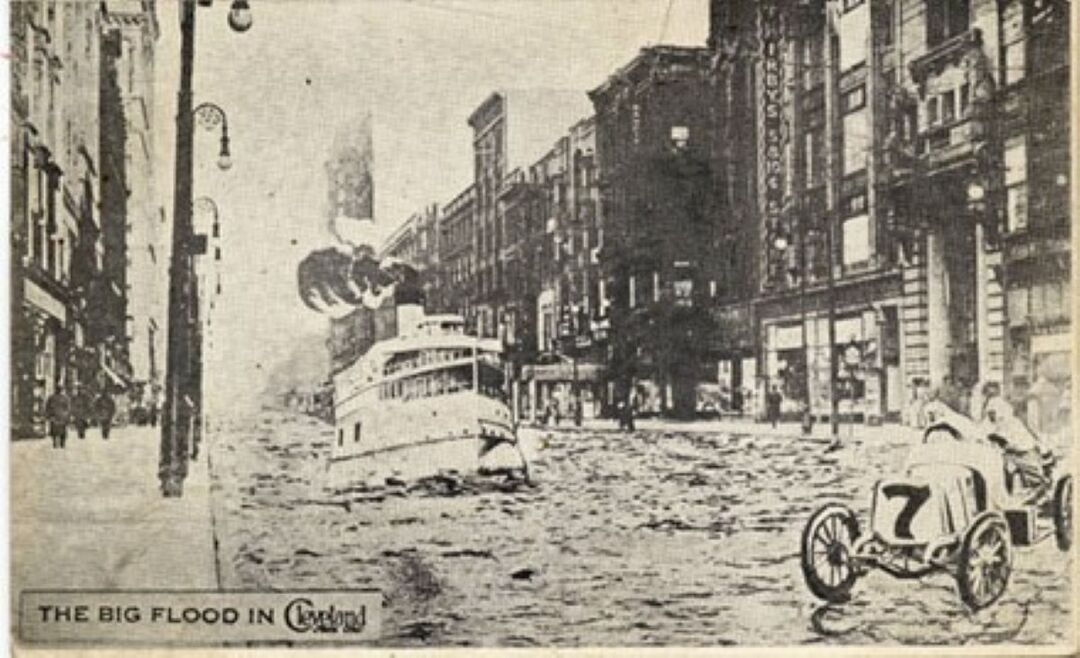
Over a century ago in 1913, a great flood devastated not only Greater Cleveland, but the entire state of Ohio, as well as 13 other states, making it the nation’s most widespread natural disaster up to that time.
The Great Flood of 1913 was a major natural disaster event that many have scarcely heard of; however, this flood drastically impacted Greater Cleveland and the state of Ohio regardless of flood prevention measures taken before and during the disastrous flood. Prior to the flood, in January and February of 1913, there was an onslaught of snowmelt that thawed early for the season and raised the water levels of the Cuyahoga, Licking, Scioto, and Muskingum Rivers higher than average. On March 23 it began to rain, and rain continued for four days. Within only a few days, Ohio was drowning in rainfall levels that are typically only achieved in a two-to-three-month period. The worst-hit city in Ohio, and arguably in the nation, was Dayton which had flood waters reach 20 feet high. When this catastrophic flooding occurred, there was not much anyone could do. Some were able to evacuate, but many were unable to leave and had to wait out the storm.
During the storm, there were not many actions local officials could take to preserve homes, businesses, infrastructure, and most importantly life. Since there had been previous floods along the Cuyahoga River, many assumed that the dams would hold back a considerable amount of water from the city. However, these dams that were put in place to prevent catastrophic flooding were pushed to their limits. One Akron dam failed, pushing even more flood waters through Greater Cleveland. Local officials attempted to alleviate some of the flooding along the Ohio & Erie Canal by dynamiting several canal locks. Despite these preemptive actions, flooding was still severe in Greater Cleveland.
Local public officials attempted to preserve life during this massive flooding event. Officials called to evacuate people to higher ground; however, some individuals were caught in the path of the storm. Cuyahoga Lumber workers were trapped while attempting to preserve their lumber stock. In addition, train depot workers also became trapped and had to be rescued from the second floor of the depot. It was not only workers who had to be rescued from the flooding but also families. In one instance, four children and two parents were rescued from their home because they could not evacuate because the children had measles.
Launching rescue boats during the storm was a dangerous and arduous venture. The fire stations launched rescue operations because they possessed the necessary equipment for rescuing people from the flood waters: pulleys, ropes, and life preservers. The Flats were particularly difficult for rescue boats to navigate due to debris in the water and the strength of the current. In the Flats, several boats flipped while attempting to rescue people. In effect, while trying to prevent loss of life, many individuals inadvertently put their own lives at risk. Fortunately, no one perished while attempting to rescue those caught in the flood waters.
It took days following the flood to determine the extent of the damage as a result of telegraph and telephone service outages, as well as general communication delays in rural areas. Eventually, it became widely known that the damage was extensive. In Ohio, at least 428 people lost their lives, and 20,000 homes and an untold number of businesses were destroyed in the Great Flood. Public infrastructure was also a concern, such as backed-up sewers, contaminated drinking water, closed and inaccessible grocery stores, washed-out railroads, and destroyed bridges. It took weeks for the flood waters to recede enough to start the cleanup effort. Over half of all the property damage caused by the Great Flood occurred in Ohio and cost $3 billion in today’s money.
There were difficult decisions to be made in the days, weeks, and years following the flood. One of the major decisions following the flood was to discontinue the commercial use of the Ohio & Erie Canal. In the first decade of the 20th century, Ohio legislators appropriated funding for a series of renovations to the canal in the hopes of making the canal become a commercial corridor like it was in the early to mid-19th century. Despite repairs, Greater Cleveland industries did not switch back to utilizing the canal. When the flood hit, it was the straw that broke the camel’s back. Although the flood ended the Ohio & Erie Canal as a commercial waterway, thanks to later natural and historic preservation efforts, people can enjoy a day of recreation along the canal’s Towpath Trail today.
Another major effect of the Great Flood was the passage of the Vonderheide Act (Ohio Conservancy Law) in 1914. This enabling legislation authorized tax-funded flood infrastructure improvements and established watershed districts. Although the law was challenged all the way up to the Supreme Court, it stood and the Miami Conservancy District in southern Ohio became the country’s first major watershed district. The state of Ohio also repaired and added new levees and dams throughout the Ohio Valley with the hope of staving off any future major flooding event.
Although the Great Flood caused extensive damage across numerous states, the disaster is not widely known because the flood is often conceptualized in innumerable cities and towns as a local event rather than a large multistate event. Many may come across floods that are labeled locally, such as the Great Dayton Flood or the Great Indianapolis Flood, but all these floods occurred in March 1913 as part of a larger event. The Great Flood caused extensive damage that changed Ohio’s laws, flood precautions, and ended a major commercial waterway earning the flood its title as “Ohio’s greatest weather event.”
Images








